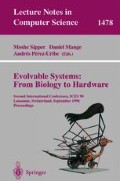Abstract
Hardware evolution methodologies come into their own in the construction of real-time adaptive systems. The technological requirements for such systems are not only high-speed evolution, but also steady and smooth evolution. This paper shows that the Progressive Evolution Model (PEM) and Diploid chromosomes contribute toward satisfying these requirements in the hardware evolutionary system AdAM (Adaptive Architecture Methodology). Simulations of an artificial ant problem using four combinations of two wets of variables — PEM vs. non-PEM, and Diploid AdAM vs. Haploid AdAM — show that the Diploid-PEM combination overwhelms the others.
Preview
Unable to display preview. Download preview PDF.
References
Bruce Albers et al. MOLECULAR BIOLOGY OF THE CELL SECOND EDITION, chapter 15. Garland Publishing, Inc., 1989.
Tomofumi Hikage, Hitoshi Hemmi, and Katsunori Shimohara. Hardware evolution system introducing dominant and recessive heredity. In Evolvable Systems: From Biology to Hardware (LNCS 1259) pages 423–136. Springer, 1996.
Tomofumi Hikage, Hitoshi Hemmi, and Katsunori Shimohara. Progressive evolution model using a hardware evolution system. In Artificial Life and Robotics, pages 18–21, 1997.
Jun’ichi Mizoguchi, Hitoshi Hemmi, and Katsunori Shimohara. Production genetic algorithms for automated hardware design through an evolutionary process. In IEEE Conference on Evolutionary Computation, 1994.
R. E. Smith and D. E. Goldberg. Diploidy and dominance in artificial genetic search. Complex Systems, 6(3):251–285, 1992.
Xin Yao and Tetsuya Higuchi. Promises and challenges of evolvable hardware. In Evolvable Systems: From Biology to Hardware (LNCS 1259), pages 55–78. Springer, 1996.
Author information
Authors and Affiliations
Editor information
Rights and permissions
Copyright information
© 1998 Springer-Verlag Berlin Heidelberg
About this paper
Cite this paper
Hikage, T., Hemmi, H., Shimohara, K. (1998). Comparison of evolutionary methods for smoother evolution. In: Sipper, M., Mange, D., Pérez-Uribe, A. (eds) Evolvable Systems: From Biology to Hardware. ICES 1998. Lecture Notes in Computer Science, vol 1478. Springer, Berlin, Heidelberg. https://doi.org/10.1007/BFb0057613
Download citation
DOI: https://doi.org/10.1007/BFb0057613
Published:
Publisher Name: Springer, Berlin, Heidelberg
Print ISBN: 978-3-540-64954-0
Online ISBN: 978-3-540-49916-9
eBook Packages: Springer Book Archive

